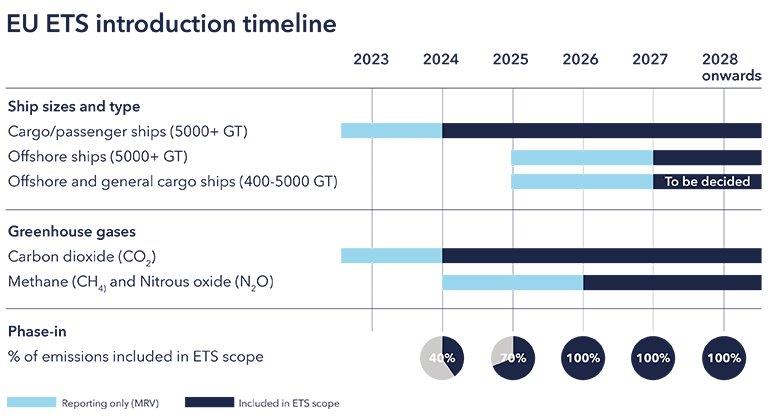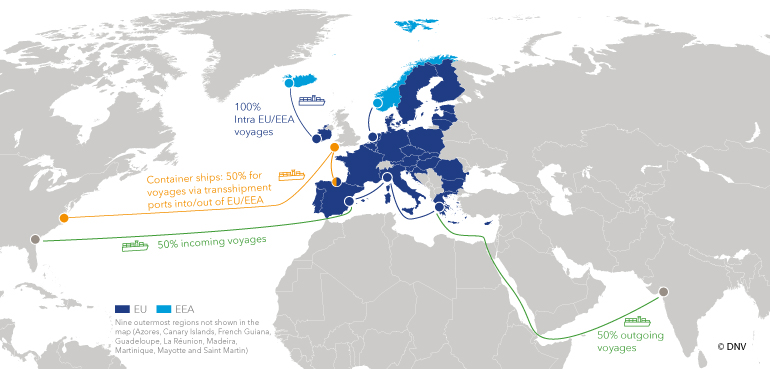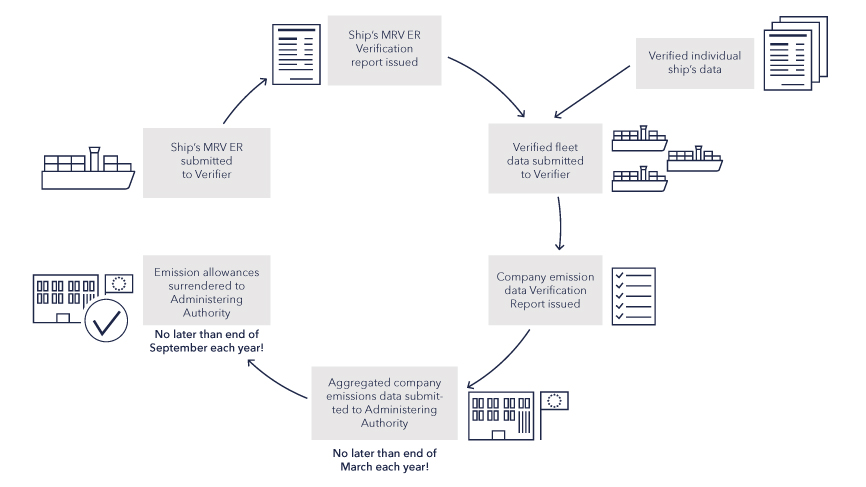The implementation timeline for shipping
The EU’s legislative bodies have adopted a revision of the EU ETS directive to include shipping from 2024.
This entails a three-year phase-in period, increasing in scope from 40% of emissions in 2024 to 70% in 2025 and 100% in 2026. It applies to cargo and passenger ships above 5000 GT from 2024 and offshore ships above 5000 GT from 2027. The EU ETS will initially cover carbon dioxide emissions and be widened to include methane and nitrous oxide from 2026. Offshore ship and general cargo ships between 400 and 5000 GT will also be required to report emissions and may be included in the EU ETS at a later stage.

What are the requirements for EU ETS compliance?
Each shipping company will need to be registered with an administering authority in the EU. Following the publication of the European Committee’s implementing acts on 1 October 2023, an updated Monitoring Plan must be submitted for verification and verified by an accredited body within three months. The verified Monitoring Plan must be submitted to the administering authority by 1 April 2024.
Starting in 2025, the shipping company must submit verified aggregated emissions data at the company level to the administering authority by 31 March of each year. This data is to be based on the MRV Emissions Reports for the previous year, in line with a revised MRV Monitoring Plan, which is required from 1 January 2024. In practice, this means the ship emissions report needs to be verified and submitted a month earlier, at the latest, than under the current MRV system.
The scope of EU ETS compliance
The emission allowances (see tab EU Allowances) corresponding to a certain amount of GHG emissions are required to be surrendered to the administering authority by 30 September of each year. Failure to surrender allowances within the deadline for a single ship can affect compliance for an entire fleet.
Companies that fail to surrender allowances are liable to an excess emissions penalty of 100 Euros per tonne of CO2 and are still liable for surrender of the required allowances. Failure to comply for two or more consecutive periods may result in the ships of the company being banned from trading in the EU.

EU ETS based on percentage of emissions on voyages
All 100% of emissions on voyages and port calls within the EU/EEA, and 50% of emissions on voyages into or out of the EU/EEA, are subject to the EU ETS. To avoid evasive behaviour, container ships stopping in transshipment ports outside the EU/EEA but less than 300 nm from an EU/EEA port, need to include 50% of the emissions for the voyage to that port as well, rather than only the short leg from the transshipment port. The EU will provide a list of transshipment ports.
EU ETS annual compliance cycle in a nutshell
The yearly EU ETS cycle begins with an individual ship’s MRV Emissions Report being submitted to a verifier, who then issues verification of the report. The individual ship data or fleet data are also sent to the verifier, who subsequently issues a Company Emissions Report. All of the company’s emissions data then need to be submitted together to the administering authority by 31 March of each year. By 30 September of each year, the emission allowances must be surrendered to the administering authority.

Source: DNV
